Leadership Management Report: Analyzing Negative Culture in X Company
VerifiedAdded on 2022/09/27
|10
|2638
|45
Report
AI Summary
This report analyzes the negative organizational culture of X Company, a multinational financial institution, focusing on a specific branch. The report defines organizational culture and highlights its impact on employee behavior, satisfaction, and turnover. It identifies key issues within X Company, including top-down communication, lack of employee input, poor working conditions, conflicts, and employee demotivation. The analysis applies problem-solving and decision-making theories to address these issues, recommending that X Company implement a more decentralized structure, improve communication channels, empower branch managers, and prioritize employee well-being through training, recognition, and ethical practices. The report concludes by emphasizing the importance of a positive organizational culture for reducing employee turnover, improving customer service, and enhancing overall work quality.
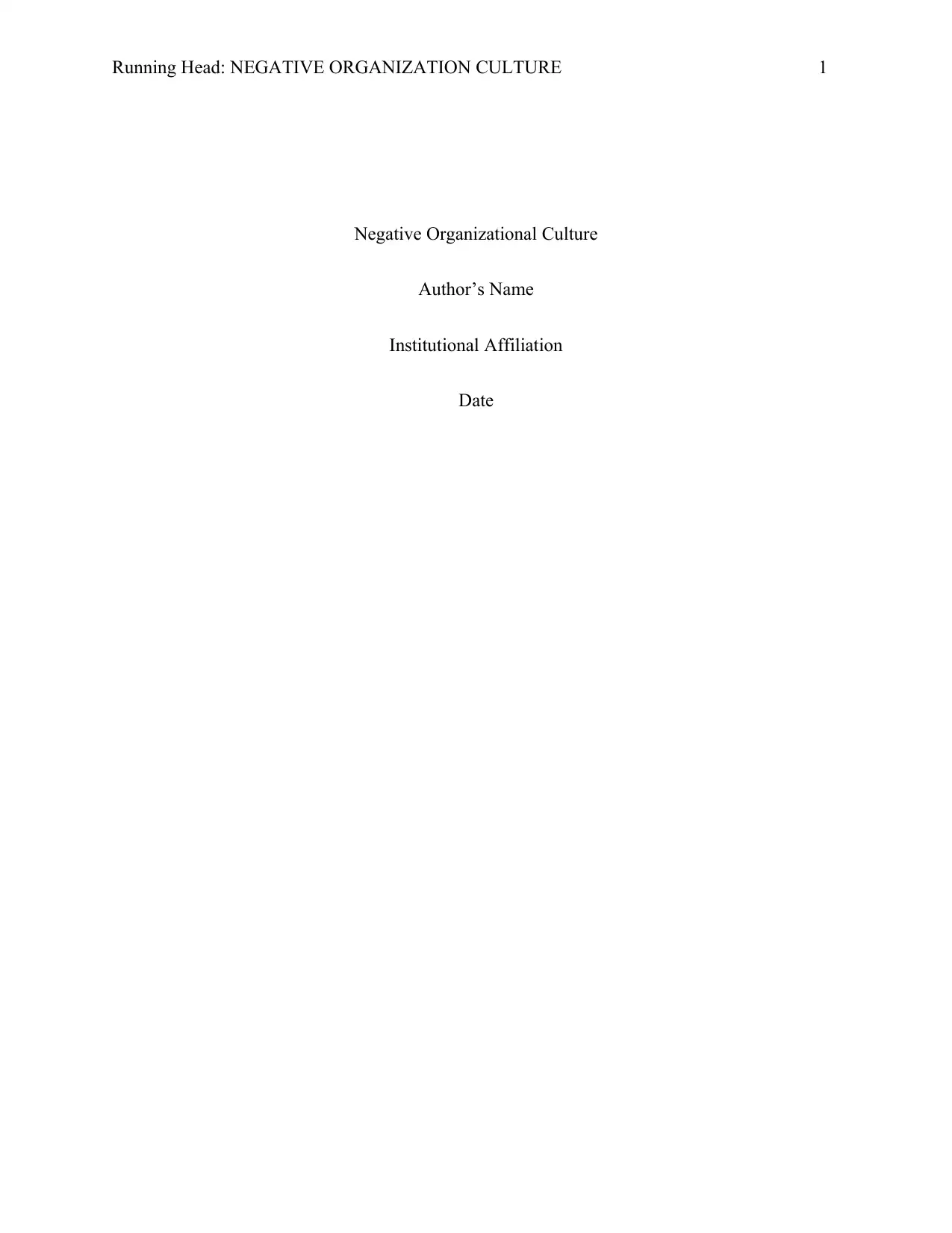
Running Head: NEGATIVE ORGANIZATION CULTURE 1
Negative Organizational Culture
Author’s Name
Institutional Affiliation
Date
Negative Organizational Culture
Author’s Name
Institutional Affiliation
Date
Paraphrase This Document
Need a fresh take? Get an instant paraphrase of this document with our AI Paraphraser
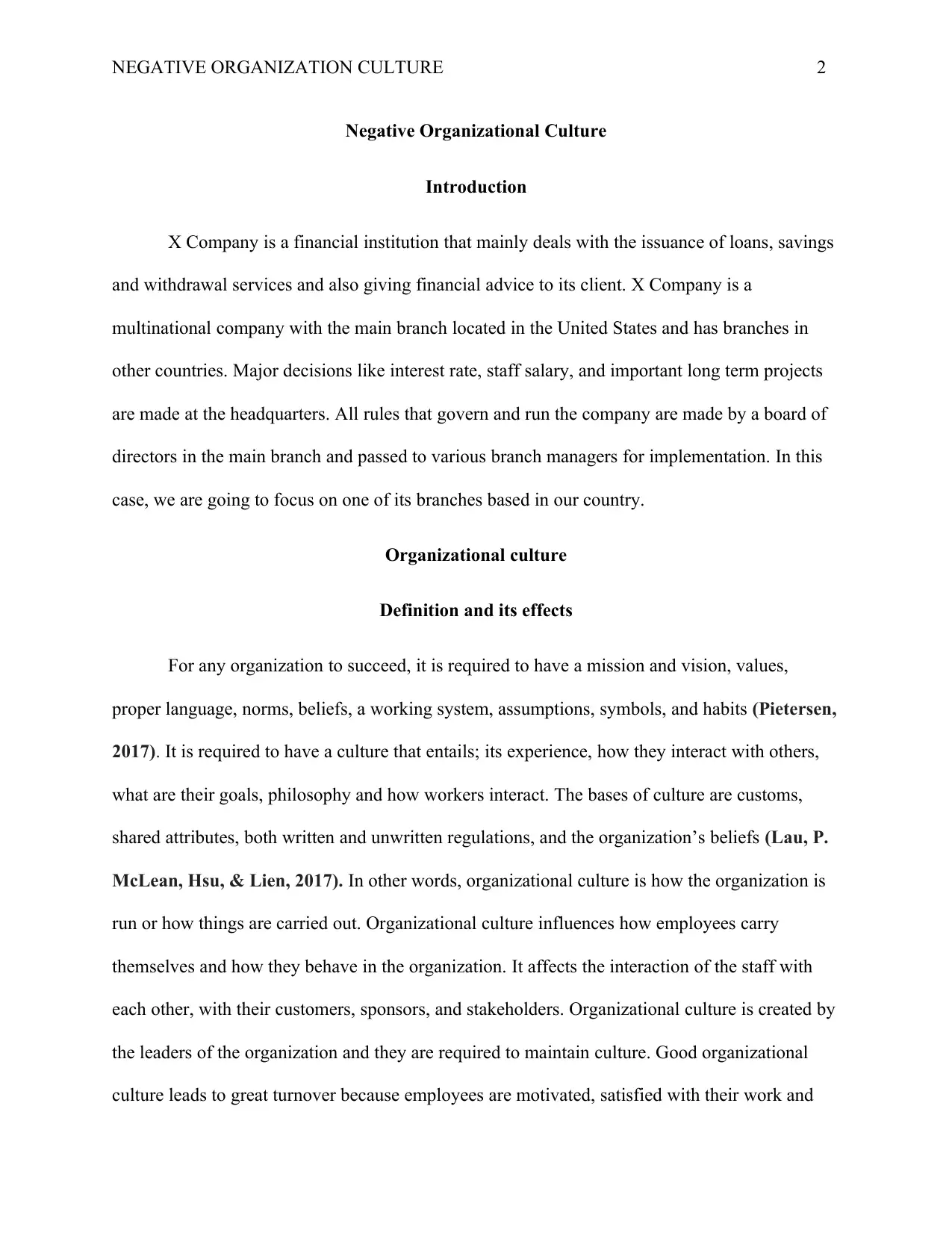
NEGATIVE ORGANIZATION CULTURE 2
Negative Organizational Culture
Introduction
X Company is a financial institution that mainly deals with the issuance of loans, savings
and withdrawal services and also giving financial advice to its client. X Company is a
multinational company with the main branch located in the United States and has branches in
other countries. Major decisions like interest rate, staff salary, and important long term projects
are made at the headquarters. All rules that govern and run the company are made by a board of
directors in the main branch and passed to various branch managers for implementation. In this
case, we are going to focus on one of its branches based in our country.
Organizational culture
Definition and its effects
For any organization to succeed, it is required to have a mission and vision, values,
proper language, norms, beliefs, a working system, assumptions, symbols, and habits (Pietersen,
2017). It is required to have a culture that entails; its experience, how they interact with others,
what are their goals, philosophy and how workers interact. The bases of culture are customs,
shared attributes, both written and unwritten regulations, and the organization’s beliefs (Lau, P.
McLean, Hsu, & Lien, 2017). In other words, organizational culture is how the organization is
run or how things are carried out. Organizational culture influences how employees carry
themselves and how they behave in the organization. It affects the interaction of the staff with
each other, with their customers, sponsors, and stakeholders. Organizational culture is created by
the leaders of the organization and they are required to maintain culture. Good organizational
culture leads to great turnover because employees are motivated, satisfied with their work and
Negative Organizational Culture
Introduction
X Company is a financial institution that mainly deals with the issuance of loans, savings
and withdrawal services and also giving financial advice to its client. X Company is a
multinational company with the main branch located in the United States and has branches in
other countries. Major decisions like interest rate, staff salary, and important long term projects
are made at the headquarters. All rules that govern and run the company are made by a board of
directors in the main branch and passed to various branch managers for implementation. In this
case, we are going to focus on one of its branches based in our country.
Organizational culture
Definition and its effects
For any organization to succeed, it is required to have a mission and vision, values,
proper language, norms, beliefs, a working system, assumptions, symbols, and habits (Pietersen,
2017). It is required to have a culture that entails; its experience, how they interact with others,
what are their goals, philosophy and how workers interact. The bases of culture are customs,
shared attributes, both written and unwritten regulations, and the organization’s beliefs (Lau, P.
McLean, Hsu, & Lien, 2017). In other words, organizational culture is how the organization is
run or how things are carried out. Organizational culture influences how employees carry
themselves and how they behave in the organization. It affects the interaction of the staff with
each other, with their customers, sponsors, and stakeholders. Organizational culture is created by
the leaders of the organization and they are required to maintain culture. Good organizational
culture leads to great turnover because employees are motivated, satisfied with their work and
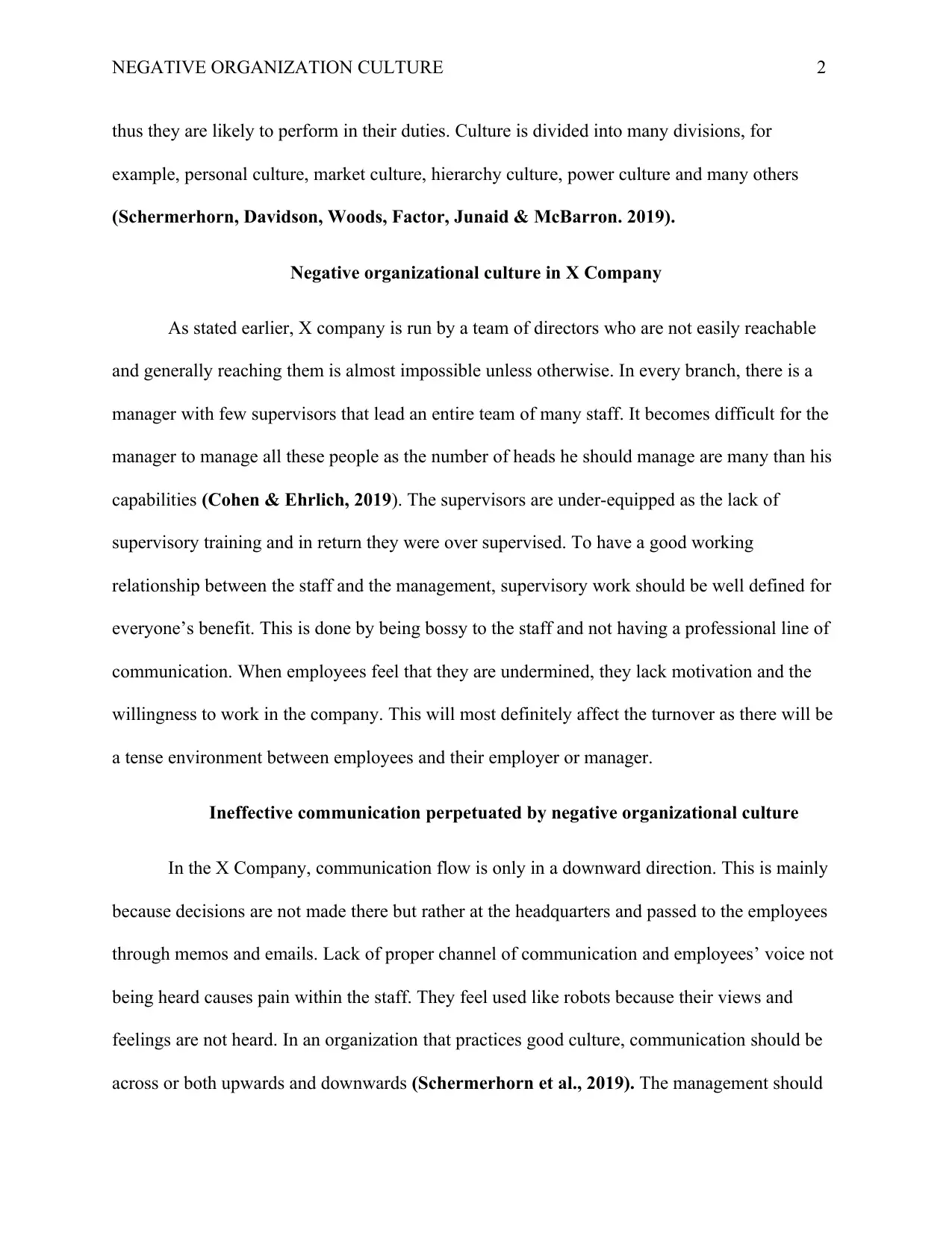
NEGATIVE ORGANIZATION CULTURE 2
thus they are likely to perform in their duties. Culture is divided into many divisions, for
example, personal culture, market culture, hierarchy culture, power culture and many others
(Schermerhorn, Davidson, Woods, Factor, Junaid & McBarron. 2019).
Negative organizational culture in X Company
As stated earlier, X company is run by a team of directors who are not easily reachable
and generally reaching them is almost impossible unless otherwise. In every branch, there is a
manager with few supervisors that lead an entire team of many staff. It becomes difficult for the
manager to manage all these people as the number of heads he should manage are many than his
capabilities (Cohen & Ehrlich, 2019). The supervisors are under-equipped as the lack of
supervisory training and in return they were over supervised. To have a good working
relationship between the staff and the management, supervisory work should be well defined for
everyone’s benefit. This is done by being bossy to the staff and not having a professional line of
communication. When employees feel that they are undermined, they lack motivation and the
willingness to work in the company. This will most definitely affect the turnover as there will be
a tense environment between employees and their employer or manager.
Ineffective communication perpetuated by negative organizational culture
In the X Company, communication flow is only in a downward direction. This is mainly
because decisions are not made there but rather at the headquarters and passed to the employees
through memos and emails. Lack of proper channel of communication and employees’ voice not
being heard causes pain within the staff. They feel used like robots because their views and
feelings are not heard. In an organization that practices good culture, communication should be
across or both upwards and downwards (Schermerhorn et al., 2019). The management should
thus they are likely to perform in their duties. Culture is divided into many divisions, for
example, personal culture, market culture, hierarchy culture, power culture and many others
(Schermerhorn, Davidson, Woods, Factor, Junaid & McBarron. 2019).
Negative organizational culture in X Company
As stated earlier, X company is run by a team of directors who are not easily reachable
and generally reaching them is almost impossible unless otherwise. In every branch, there is a
manager with few supervisors that lead an entire team of many staff. It becomes difficult for the
manager to manage all these people as the number of heads he should manage are many than his
capabilities (Cohen & Ehrlich, 2019). The supervisors are under-equipped as the lack of
supervisory training and in return they were over supervised. To have a good working
relationship between the staff and the management, supervisory work should be well defined for
everyone’s benefit. This is done by being bossy to the staff and not having a professional line of
communication. When employees feel that they are undermined, they lack motivation and the
willingness to work in the company. This will most definitely affect the turnover as there will be
a tense environment between employees and their employer or manager.
Ineffective communication perpetuated by negative organizational culture
In the X Company, communication flow is only in a downward direction. This is mainly
because decisions are not made there but rather at the headquarters and passed to the employees
through memos and emails. Lack of proper channel of communication and employees’ voice not
being heard causes pain within the staff. They feel used like robots because their views and
feelings are not heard. In an organization that practices good culture, communication should be
across or both upwards and downwards (Schermerhorn et al., 2019). The management should
⊘ This is a preview!⊘
Do you want full access?
Subscribe today to unlock all pages.

Trusted by 1+ million students worldwide

NEGATIVE ORGANIZATION CULTURE 2
frequently ask how the employees feel about an issue rather than just dictating. X company does
not listen to the staff's opinions as they hate critics and therefore the needs and welfare of the
employees are not catered for.
Poor working conditions
Employees of X Company are not satisfied with the working conditions. Too many rules
and regulations and lack of anyone to listen to their needs make them angry and thus they keep
on leaving the company in search of better opportunities (Schermerhorn et al,. 2019). This
leads to high turnover because when the employees leave, it takes time for the headquarters to
give a go forward to replace those employees. High turnover is a cultural problem within an
organization that is brought up by strict rules and lack of a voice by the employees. With the
high turnover in X Company, some of the duties are left undone and customers are not satisfied
due to the long waiting period to be served. This has made clients of X Company shift to other
financial institutions where they will get better services within the shortest time possible.
Conflicts and tension
X Company has a lot of conflicts among the employees and tension between the
managers and the employees. The manager and supervisors choose to ignore the tension and the
heavy dark air in the working environment. The management fails to ask employees why people
are leaving the job and on the other hand, the staff does not pass reasons or explanations why
people are leaving the job to their manager. This makes employees feel as if they are walking to
their death every morning when going to their jobs (Cohen et al., 2019). The same feeling runs
throughout the day and in consequence the job performance of these employees are affected. The
relationship between the staff and the outside world is also negatively affected by this feeling.
frequently ask how the employees feel about an issue rather than just dictating. X company does
not listen to the staff's opinions as they hate critics and therefore the needs and welfare of the
employees are not catered for.
Poor working conditions
Employees of X Company are not satisfied with the working conditions. Too many rules
and regulations and lack of anyone to listen to their needs make them angry and thus they keep
on leaving the company in search of better opportunities (Schermerhorn et al,. 2019). This
leads to high turnover because when the employees leave, it takes time for the headquarters to
give a go forward to replace those employees. High turnover is a cultural problem within an
organization that is brought up by strict rules and lack of a voice by the employees. With the
high turnover in X Company, some of the duties are left undone and customers are not satisfied
due to the long waiting period to be served. This has made clients of X Company shift to other
financial institutions where they will get better services within the shortest time possible.
Conflicts and tension
X Company has a lot of conflicts among the employees and tension between the
managers and the employees. The manager and supervisors choose to ignore the tension and the
heavy dark air in the working environment. The management fails to ask employees why people
are leaving the job and on the other hand, the staff does not pass reasons or explanations why
people are leaving the job to their manager. This makes employees feel as if they are walking to
their death every morning when going to their jobs (Cohen et al., 2019). The same feeling runs
throughout the day and in consequence the job performance of these employees are affected. The
relationship between the staff and the outside world is also negatively affected by this feeling.
Paraphrase This Document
Need a fresh take? Get an instant paraphrase of this document with our AI Paraphraser

NEGATIVE ORGANIZATION CULTURE 2
Boredom among employees
Due to the above-mentioned problem in X Company, employees are unhappy, bored and
demotivated. These can be easily spotted when you look at how they offer their services and how
they walk and talk to the people around them. The attendance of the employees is affected as
they regularly miss work during working days and in most cases report to work late. Lack of
anyone to listen to their needs is one of the major causes that make them demoralized and
demotivated (Cohen et al., 2019). X company has therefore been suffering from low work
turnover as a bored person cannot perform his/ her duties as expected.
Problem-solving theory
Application of the theory
X company management should identify the problems within the organization. The
management should come up with a good thought process that will help them get the required
knowledge to solve the existing problems (Funke, & Frensch, 2017). The problem should be
analyzed and assessed according to dynamics. How complex the situation is will determine the
amount of time and work required to solve the problem (Cabanes, Hubac, Le, & Weil, 2016). It
is advantageous to solve a problem when the conditions are stable and when there are no
changes. X Company should analyze the problem making its employees leave their job. Is it poor
pay or is it poor working conditions? Why do these employees look unhappy and demoralized?
Why does the working environment feel tense? Is it conducive to our workers? Is the working
relationship between the management and the staff okay? Identifying this problem is the first
step in being able to solve them.
Boredom among employees
Due to the above-mentioned problem in X Company, employees are unhappy, bored and
demotivated. These can be easily spotted when you look at how they offer their services and how
they walk and talk to the people around them. The attendance of the employees is affected as
they regularly miss work during working days and in most cases report to work late. Lack of
anyone to listen to their needs is one of the major causes that make them demoralized and
demotivated (Cohen et al., 2019). X company has therefore been suffering from low work
turnover as a bored person cannot perform his/ her duties as expected.
Problem-solving theory
Application of the theory
X company management should identify the problems within the organization. The
management should come up with a good thought process that will help them get the required
knowledge to solve the existing problems (Funke, & Frensch, 2017). The problem should be
analyzed and assessed according to dynamics. How complex the situation is will determine the
amount of time and work required to solve the problem (Cabanes, Hubac, Le, & Weil, 2016). It
is advantageous to solve a problem when the conditions are stable and when there are no
changes. X Company should analyze the problem making its employees leave their job. Is it poor
pay or is it poor working conditions? Why do these employees look unhappy and demoralized?
Why does the working environment feel tense? Is it conducive to our workers? Is the working
relationship between the management and the staff okay? Identifying this problem is the first
step in being able to solve them.
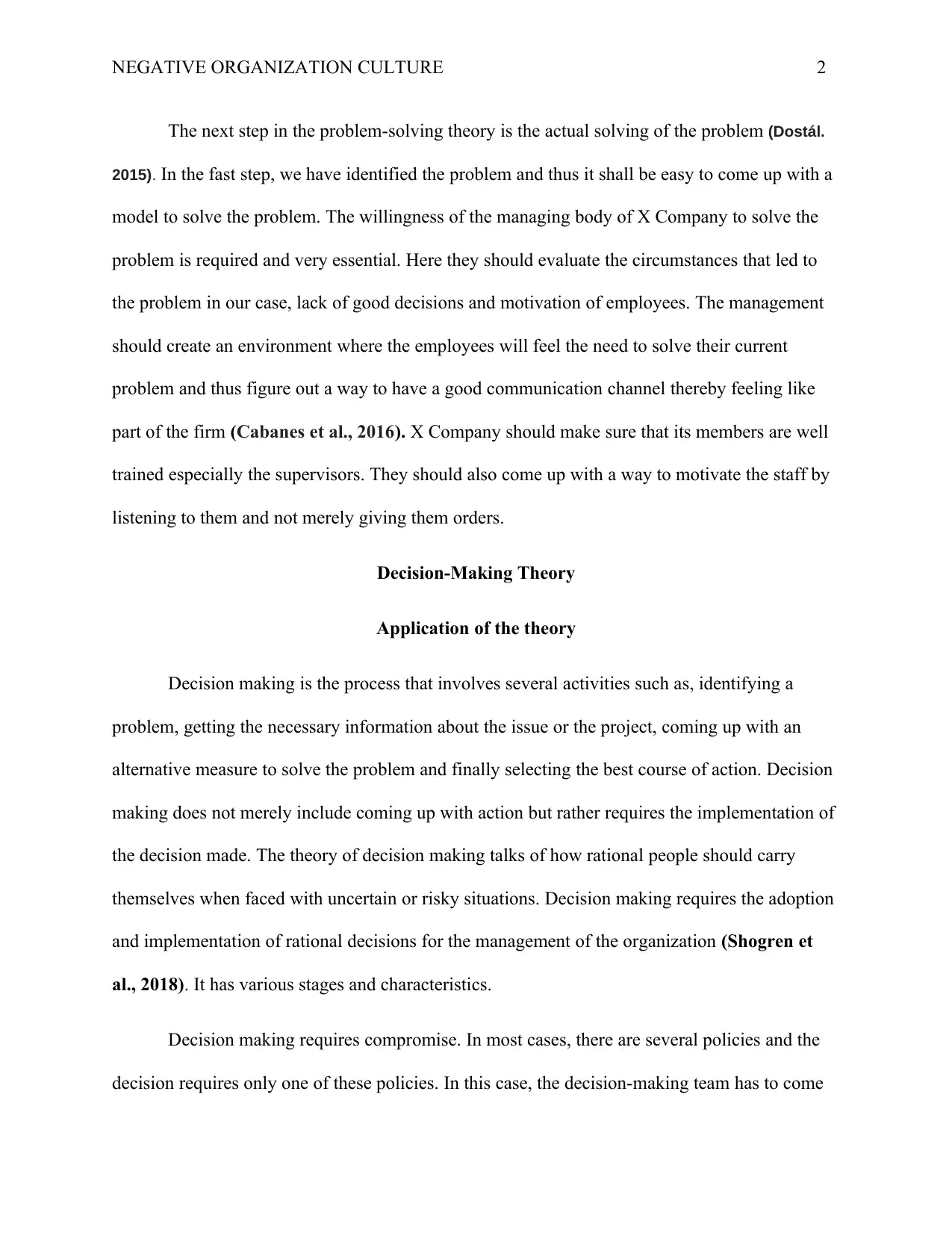
NEGATIVE ORGANIZATION CULTURE 2
The next step in the problem-solving theory is the actual solving of the problem (Dostál.
2015). In the fast step, we have identified the problem and thus it shall be easy to come up with a
model to solve the problem. The willingness of the managing body of X Company to solve the
problem is required and very essential. Here they should evaluate the circumstances that led to
the problem in our case, lack of good decisions and motivation of employees. The management
should create an environment where the employees will feel the need to solve their current
problem and thus figure out a way to have a good communication channel thereby feeling like
part of the firm (Cabanes et al., 2016). X Company should make sure that its members are well
trained especially the supervisors. They should also come up with a way to motivate the staff by
listening to them and not merely giving them orders.
Decision-Making Theory
Application of the theory
Decision making is the process that involves several activities such as, identifying a
problem, getting the necessary information about the issue or the project, coming up with an
alternative measure to solve the problem and finally selecting the best course of action. Decision
making does not merely include coming up with action but rather requires the implementation of
the decision made. The theory of decision making talks of how rational people should carry
themselves when faced with uncertain or risky situations. Decision making requires the adoption
and implementation of rational decisions for the management of the organization (Shogren et
al., 2018). It has various stages and characteristics.
Decision making requires compromise. In most cases, there are several policies and the
decision requires only one of these policies. In this case, the decision-making team has to come
The next step in the problem-solving theory is the actual solving of the problem (Dostál.
2015). In the fast step, we have identified the problem and thus it shall be easy to come up with a
model to solve the problem. The willingness of the managing body of X Company to solve the
problem is required and very essential. Here they should evaluate the circumstances that led to
the problem in our case, lack of good decisions and motivation of employees. The management
should create an environment where the employees will feel the need to solve their current
problem and thus figure out a way to have a good communication channel thereby feeling like
part of the firm (Cabanes et al., 2016). X Company should make sure that its members are well
trained especially the supervisors. They should also come up with a way to motivate the staff by
listening to them and not merely giving them orders.
Decision-Making Theory
Application of the theory
Decision making is the process that involves several activities such as, identifying a
problem, getting the necessary information about the issue or the project, coming up with an
alternative measure to solve the problem and finally selecting the best course of action. Decision
making does not merely include coming up with action but rather requires the implementation of
the decision made. The theory of decision making talks of how rational people should carry
themselves when faced with uncertain or risky situations. Decision making requires the adoption
and implementation of rational decisions for the management of the organization (Shogren et
al., 2018). It has various stages and characteristics.
Decision making requires compromise. In most cases, there are several policies and the
decision requires only one of these policies. In this case, the decision-making team has to come
⊘ This is a preview!⊘
Do you want full access?
Subscribe today to unlock all pages.

Trusted by 1+ million students worldwide
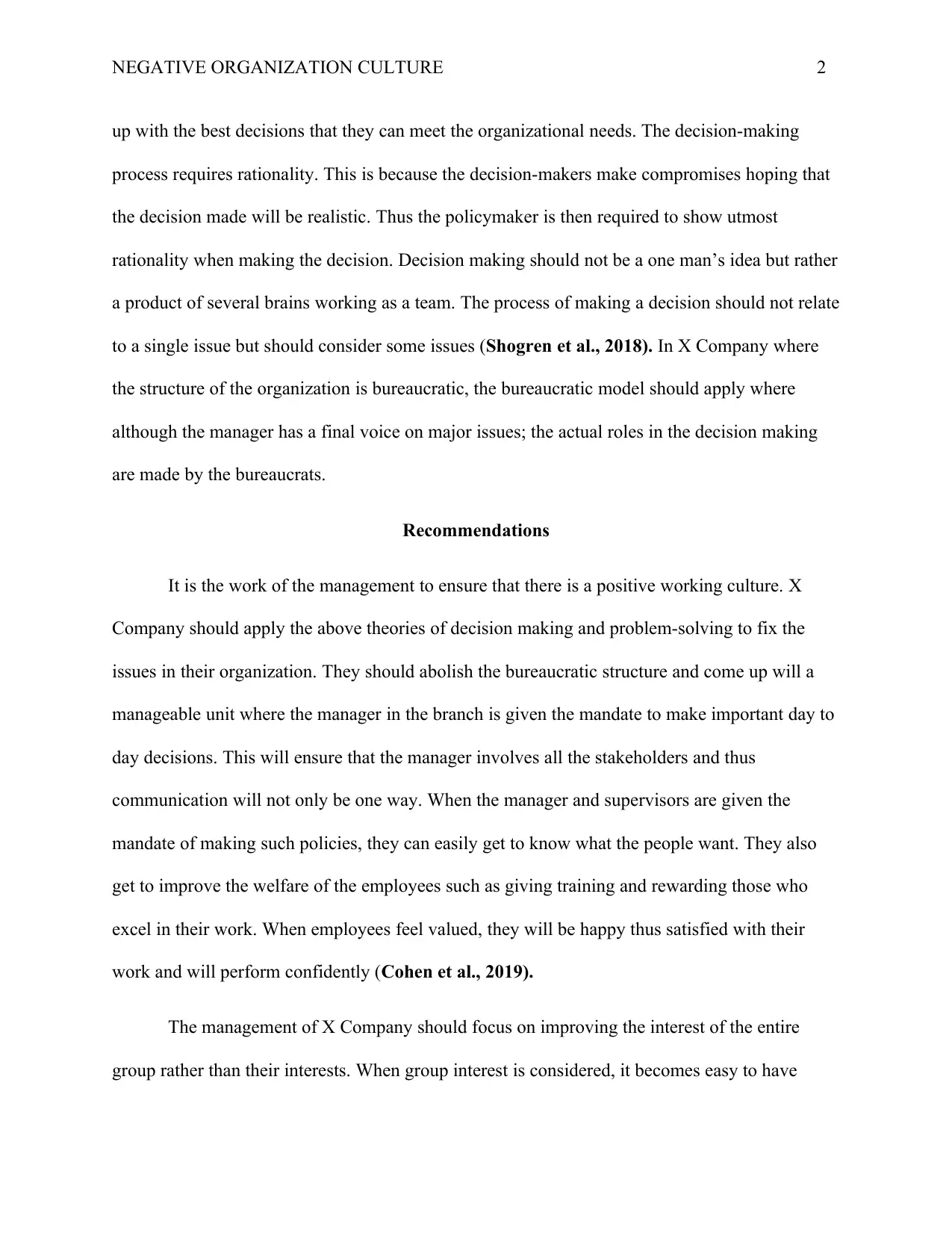
NEGATIVE ORGANIZATION CULTURE 2
up with the best decisions that they can meet the organizational needs. The decision-making
process requires rationality. This is because the decision-makers make compromises hoping that
the decision made will be realistic. Thus the policymaker is then required to show utmost
rationality when making the decision. Decision making should not be a one man’s idea but rather
a product of several brains working as a team. The process of making a decision should not relate
to a single issue but should consider some issues (Shogren et al., 2018). In X Company where
the structure of the organization is bureaucratic, the bureaucratic model should apply where
although the manager has a final voice on major issues; the actual roles in the decision making
are made by the bureaucrats.
Recommendations
It is the work of the management to ensure that there is a positive working culture. X
Company should apply the above theories of decision making and problem-solving to fix the
issues in their organization. They should abolish the bureaucratic structure and come up will a
manageable unit where the manager in the branch is given the mandate to make important day to
day decisions. This will ensure that the manager involves all the stakeholders and thus
communication will not only be one way. When the manager and supervisors are given the
mandate of making such policies, they can easily get to know what the people want. They also
get to improve the welfare of the employees such as giving training and rewarding those who
excel in their work. When employees feel valued, they will be happy thus satisfied with their
work and will perform confidently (Cohen et al., 2019).
The management of X Company should focus on improving the interest of the entire
group rather than their interests. When group interest is considered, it becomes easy to have
up with the best decisions that they can meet the organizational needs. The decision-making
process requires rationality. This is because the decision-makers make compromises hoping that
the decision made will be realistic. Thus the policymaker is then required to show utmost
rationality when making the decision. Decision making should not be a one man’s idea but rather
a product of several brains working as a team. The process of making a decision should not relate
to a single issue but should consider some issues (Shogren et al., 2018). In X Company where
the structure of the organization is bureaucratic, the bureaucratic model should apply where
although the manager has a final voice on major issues; the actual roles in the decision making
are made by the bureaucrats.
Recommendations
It is the work of the management to ensure that there is a positive working culture. X
Company should apply the above theories of decision making and problem-solving to fix the
issues in their organization. They should abolish the bureaucratic structure and come up will a
manageable unit where the manager in the branch is given the mandate to make important day to
day decisions. This will ensure that the manager involves all the stakeholders and thus
communication will not only be one way. When the manager and supervisors are given the
mandate of making such policies, they can easily get to know what the people want. They also
get to improve the welfare of the employees such as giving training and rewarding those who
excel in their work. When employees feel valued, they will be happy thus satisfied with their
work and will perform confidently (Cohen et al., 2019).
The management of X Company should focus on improving the interest of the entire
group rather than their interests. When group interest is considered, it becomes easy to have
Paraphrase This Document
Need a fresh take? Get an instant paraphrase of this document with our AI Paraphraser
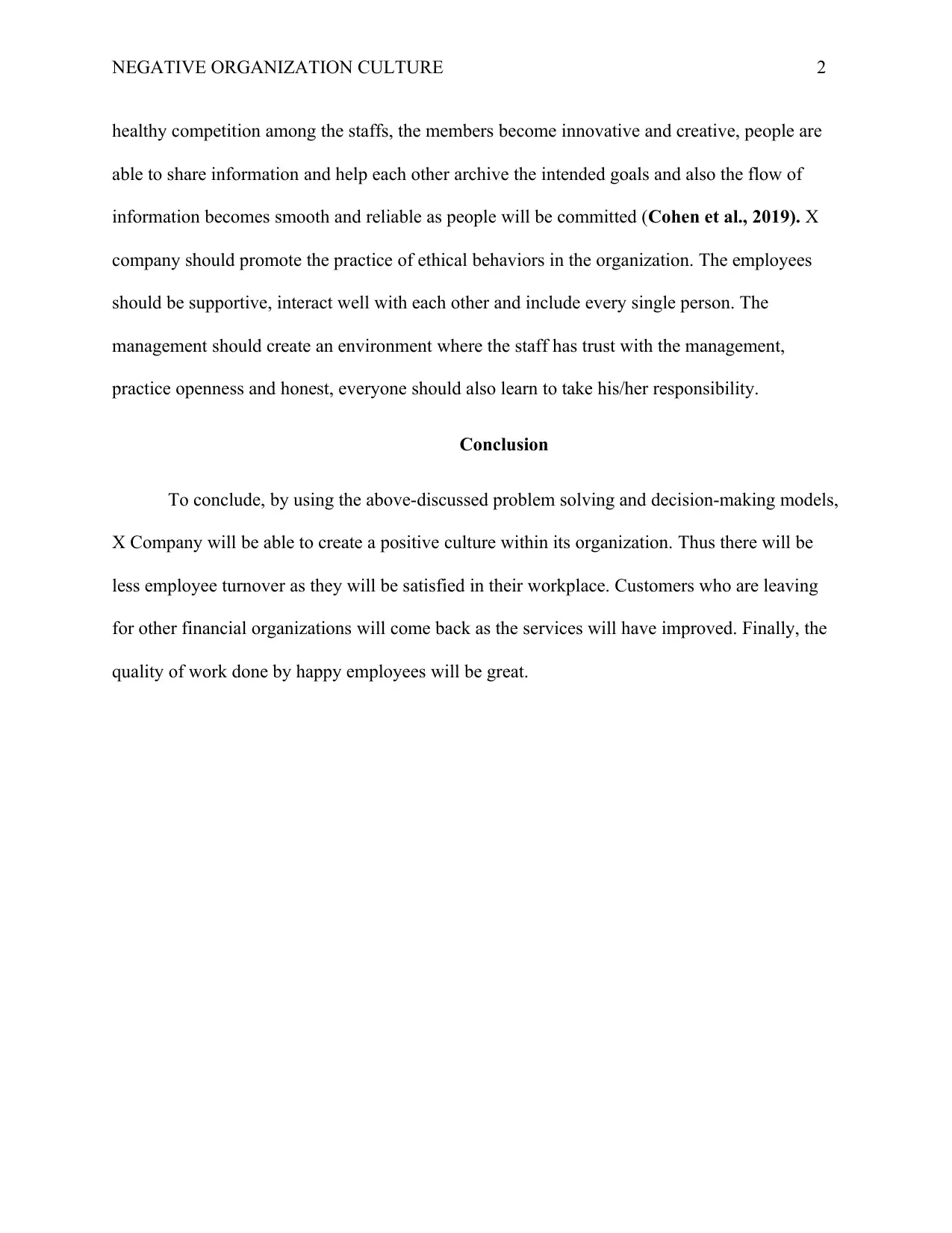
NEGATIVE ORGANIZATION CULTURE 2
healthy competition among the staffs, the members become innovative and creative, people are
able to share information and help each other archive the intended goals and also the flow of
information becomes smooth and reliable as people will be committed (Cohen et al., 2019). X
company should promote the practice of ethical behaviors in the organization. The employees
should be supportive, interact well with each other and include every single person. The
management should create an environment where the staff has trust with the management,
practice openness and honest, everyone should also learn to take his/her responsibility.
Conclusion
To conclude, by using the above-discussed problem solving and decision-making models,
X Company will be able to create a positive culture within its organization. Thus there will be
less employee turnover as they will be satisfied in their workplace. Customers who are leaving
for other financial organizations will come back as the services will have improved. Finally, the
quality of work done by happy employees will be great.
healthy competition among the staffs, the members become innovative and creative, people are
able to share information and help each other archive the intended goals and also the flow of
information becomes smooth and reliable as people will be committed (Cohen et al., 2019). X
company should promote the practice of ethical behaviors in the organization. The employees
should be supportive, interact well with each other and include every single person. The
management should create an environment where the staff has trust with the management,
practice openness and honest, everyone should also learn to take his/her responsibility.
Conclusion
To conclude, by using the above-discussed problem solving and decision-making models,
X Company will be able to create a positive culture within its organization. Thus there will be
less employee turnover as they will be satisfied in their workplace. Customers who are leaving
for other financial organizations will come back as the services will have improved. Finally, the
quality of work done by happy employees will be great.

NEGATIVE ORGANIZATION CULTURE 2
References
Cabanes, B., Hubac, S., Le Masson, P., & Weil, B. (2016, May). From FMEA as a problem
solving method to a design-oriented process: Toward a design perspective of FMEA.
Cohen, A., & Ehrlich, S. (2019). Exchange variables, organizational culture and their
relationship with constructive deviance. Management Research Review. Emerald
Publishing Limited.
Dostál, J. (2015). Theory of problem solving. Procedia-Social and Behavioral Sciences, 174(1),
2798-2805.
Funke, J., & Frensch, P. A. (2017). Complex problem solving: The European perspective—10
years after. In Learning to solve complex scientific problems (pp. 25-48). Routledge.
Lau, P. Y. Y., McLean, G. N., Hsu, Y. C., & Lien, B. Y. H. (2017). Learning organization,
organizational culture, and affective commitment in Malaysia: A person–organization fit
theory. Human Resource Development International, 20(2), 159-179.
Pietersen, C. (2017). Organizational culture: a foundational perspective. African Journal of
Economic and Management Studies, 8(3), 262-273.
Shogren, K. A., Wehmeyer, M. L., Martinis, J., & Blanck, P. (2018). Supported decision-
making: Theory, research, and practice to enhance self-determination and quality of life.
Cambridge University Press. Retrieved from: https://books.google.co.ke/books?
hl=en&lr=&id=aHaIDwAAQBAJ&oi=fnd&pg=PR18&dq=Shogren,+K.+A.,+Wehmeyer,+M.+L.,
References
Cabanes, B., Hubac, S., Le Masson, P., & Weil, B. (2016, May). From FMEA as a problem
solving method to a design-oriented process: Toward a design perspective of FMEA.
Cohen, A., & Ehrlich, S. (2019). Exchange variables, organizational culture and their
relationship with constructive deviance. Management Research Review. Emerald
Publishing Limited.
Dostál, J. (2015). Theory of problem solving. Procedia-Social and Behavioral Sciences, 174(1),
2798-2805.
Funke, J., & Frensch, P. A. (2017). Complex problem solving: The European perspective—10
years after. In Learning to solve complex scientific problems (pp. 25-48). Routledge.
Lau, P. Y. Y., McLean, G. N., Hsu, Y. C., & Lien, B. Y. H. (2017). Learning organization,
organizational culture, and affective commitment in Malaysia: A person–organization fit
theory. Human Resource Development International, 20(2), 159-179.
Pietersen, C. (2017). Organizational culture: a foundational perspective. African Journal of
Economic and Management Studies, 8(3), 262-273.
Shogren, K. A., Wehmeyer, M. L., Martinis, J., & Blanck, P. (2018). Supported decision-
making: Theory, research, and practice to enhance self-determination and quality of life.
Cambridge University Press. Retrieved from: https://books.google.co.ke/books?
hl=en&lr=&id=aHaIDwAAQBAJ&oi=fnd&pg=PR18&dq=Shogren,+K.+A.,+Wehmeyer,+M.+L.,
⊘ This is a preview!⊘
Do you want full access?
Subscribe today to unlock all pages.

Trusted by 1+ million students worldwide

NEGATIVE ORGANIZATION CULTURE 2
+Martinis,+J.,+%26+Blanck,+P.+(2018).+Supported+decision-+making:+Theory,+research,
+and+practice+to+enhance+self-determination+and+quality+of+life.
+Cambridge+University+Press.&ots=TSlY3mY4N5&sig=o8klRftMZ_C6HByIUAKsZsXHldU&redir_e
sc=y#v=onepage&q=Shogren%2C%20K.%20A.%2C%20Wehmeyer%2C%20M.%20L.%2C
%20Martinis%2C%20J.%2C%20%26%20Blanck%2C%20P.%20(2018).%20Supported%20decision-
%20making%3A%20Theory%2C%20research%2C%20and%20practice%20to%20enhance
%20self-determination%20and%20quality%20of%20life.%20Cambridge%20University
%20Press.&f=false
Schermerhorn Jr, J. R., Davidson, P., Woods, P., Factor, A., Junaid, F., & McBarron, E.
(2019). Management. Milton, QLD: John Wiley and Sons Australia, Ltd, 2020.
+Martinis,+J.,+%26+Blanck,+P.+(2018).+Supported+decision-+making:+Theory,+research,
+and+practice+to+enhance+self-determination+and+quality+of+life.
+Cambridge+University+Press.&ots=TSlY3mY4N5&sig=o8klRftMZ_C6HByIUAKsZsXHldU&redir_e
sc=y#v=onepage&q=Shogren%2C%20K.%20A.%2C%20Wehmeyer%2C%20M.%20L.%2C
%20Martinis%2C%20J.%2C%20%26%20Blanck%2C%20P.%20(2018).%20Supported%20decision-
%20making%3A%20Theory%2C%20research%2C%20and%20practice%20to%20enhance
%20self-determination%20and%20quality%20of%20life.%20Cambridge%20University
%20Press.&f=false
Schermerhorn Jr, J. R., Davidson, P., Woods, P., Factor, A., Junaid, F., & McBarron, E.
(2019). Management. Milton, QLD: John Wiley and Sons Australia, Ltd, 2020.
1 out of 10
Related Documents
Your All-in-One AI-Powered Toolkit for Academic Success.
+13062052269
info@desklib.com
Available 24*7 on WhatsApp / Email
![[object Object]](/_next/static/media/star-bottom.7253800d.svg)
Unlock your academic potential
Copyright © 2020–2025 A2Z Services. All Rights Reserved. Developed and managed by ZUCOL.





